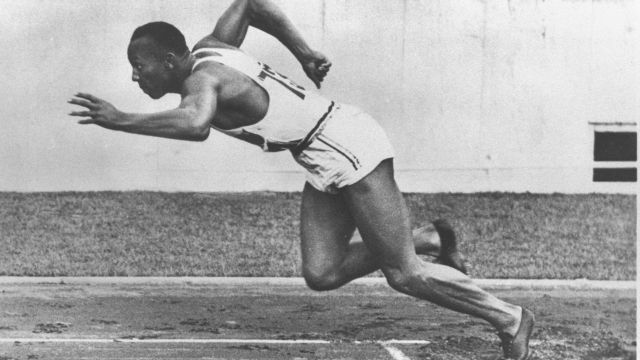‘Race’ showcases Jesse Owens’ run for history

Jesse Owens of the USA starts the 200 meters event at the 1936 Olympic Games in Berlin. Owens won the gold medal in this event with a time of 20.7 seconds. (IOC Olympic Museum /Allsport)
He smashed stereotypes and shattered records. Now a new generation will learn about the modest runner from Oakville who never ran away from a challenge.
“Race” tells the story of Jesse Owens, the track-and-field star who won four gold medals at Adolf Hitler’s 1936 Berlin Olympics. Directed by Stephen Hopkins and starring Stephan James, the movie opens nationwide on Friday, Feb. 19.

Jesse Owens’ widow Ruth attends statue dedication.
Viewers won’t just learn about Owens the athlete. They’ll learn about the man who faced discrimination at home even as he destroyed the myth of the “superior” Aryan race in Nazi Germany.
“It is spellbinding,” said Nancy Pinion, director of the Jesse Owens Park & Museum, who watched the premiere with members of the Owens family. “We tell this story every day, but it brought it to life in a way we weren’t expecting. We were reduced to tears at some moments and cheering at others.”
“They did an exceptional job of staying true to the factual story of Jesse Owens, whether it pertains to his athletic achievements or personal story,” said Pete Enfield, president of Luminary Group LLC, which represents the Owens estate. “I think there is little doubt he was a significant participant in the civil rights movement.”
Born James Cleveland Owens in Oakville on Sept. 12, 1913, Jesse was the youngest of 10 children. His father, Henry, was a sharecropper.
“If you know Oakville and Jesse’s roots, you get a deeper meaning and understanding of his life,” said Pinion. “In the film, his track coach tells him he didn’t know if he could work hard. Owens replied that when he was 6 years old, he picked a hundred pounds of cotton a day.”
His family moved to Cleveland, Ohio, where Owens began setting records in high school. At Ohio State University, the “Buckeye Bullet” broke two world records (in the 220-yard low hurdles and broad jump) and tied another (in the 100-yard dash) in one day.
The following year, Owens qualified for the Berlin Olympics. He faced pressure from the NAACP and others to boycott the games in protest against Adolf Hitler and the Nazi Party.
Owens chose to run. And he won. He earned gold in the 100 meters, the 200 meters, the 400-meter relay and the long jump, breaking two Olympic records.
“I really think that Owens had a significant impact on the propaganda machine that was Nazi Germany,” said Scott Myers, executive director of the Alabama Sports Hall of Fame in Birmingham.

Olympic statue at the Jesse Owens Park & Museum.
Owens did more than set world records. He set a world-class example of sportsmanship. After beating him in the long jump, he walked arm-in-arm with his German competitor, Luz Long.
“It took a lot of courage for him to befriend me in front of Hitler,” said Owens, according to ESPN.com. “You can melt down all the medals and cups I have and they wouldn’t be a plating on the 24-karat friendship that I felt for Luz Long at that moment.”
“Jesse Owens became great friends with Luz Long, and Joe Louis and Max Schmeling became great friends, too,” said Myers, referring to the heavyweight champion boxer born in Lafayette. “Sports played a great role in bringing people together on all sides. It built bridges between cultures.”
Still, when Owens came home, he and his fellow African-Americans suffered the sting of segregation. Major League Baseball, for example, would not be integrated for another decade.
But Owens’ example at the Olympics changed hearts and minds worldwide.
“I don’t think there is any question that this was a spark that helped begin the whole (civil rights) movement,” said Enfield. “There is little doubt he played a key role.”
Owens had three daughters with his wife, Ruth, played in “Race” by Shanice Banton. After retiring from competition, he chose to serve the community.
“His life after the Olympics was so devoted to motivating children,” said Pinion. “A lot of people don’t know that side of the story. But in the movie, you get a sense of what a good person he was. He was always very humble.”
“Race” opens in theaters nationwide on Friday, Feb. 19.
On Thursday, Feb.18, a screening will be shown in the Davidson Center for Space Exploration at the U.S. Space & Rocket Center in Huntsville to benefit teachers.
For more information, go to the Jesse Owens Park & Museum.





